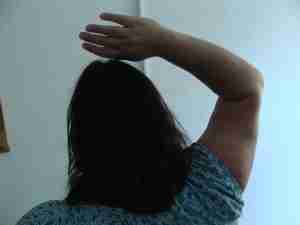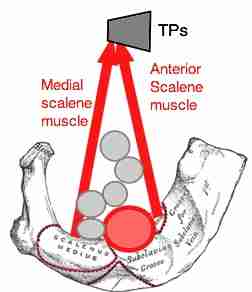- Home
- Tingling arms
- Adsons Test
Adson's Test
Adson's test is the definitive examination for a thoracic outlet syndrome.
If you are suffering from tingling in the upper limb, more often in one only, then there is an important simple test that you can do at home. Are the paresthesias, as they are known, relieved or worsened by raising your arm above your head, as in hanging the washing?

Do you get lessening of the ache or numbness by raising your arm and placing it on your head, for example? That is known as the "shoulder abduction relief" sign.
Then we are probably looking at a nerve root impingement. Perhaps a slipped disc in the cervical spine, or serious degenerative changes of the joints of Luschka in the intervertebral foramen.
Or is the pain at night relieved by placing your hand under your pillow, or under your head? That takes the traction off the nerve.
This lady had a severely pinched root in her neck from a diving accident. She gets relief by raising her arm.
Is the pain and tingling in arms and hands worsened when raising the limb? Firstly, we have to be sure this is not a shoulder condition. In a frozen adhesive capsulitis, for example, raising the upper extremity will certainly increase the symptoms.
But if the tingling is worse when you hang the washing, then there is a good chance that you have something quite different; the thoracic outlet syndrome.
Thoracic outlet syndrome is a condition seemingly far worse but in my experience the correct treatment of TOS is usually less arduous than a true pinched nerve root.
Two important structures run through the inter-scalene triangle; a group of five nerve roots called the brachial plexus, and the artery that supplies the arm.
Shoulder Abduction Relief sign
The shoulder abduction relief sign is important in ruling out a pinched nerve in the neck; do you have less pain when your arm is above your head?
Thoracic Outlet Syndrome
Thoracic outlet syndrome is caused by interference of the subclavian artery and the brachial plexus as they emerge from behind the collarbone in the upper chest; Adson's test is the classic examination to confirm the condition.

Inter scalene triangle
Inter-scalene triangle is the space between the first rib and two muscles in the neck; again Adson's test will confirm a problem, with an increase in symptoms when you place your hand on your head.
- the brachial plexus of five large nerve roots
- the subclavian artery
These structures supply the arm with blood and nerve innervation. In the thoracic outlet syndrome both may be affected resulting in your arm being without blood and nerve supply when you raise it above your head. The result is pain and a dead feeling and tingling in the upper extremity; usually one side only.
The definitive test for this condition is Adson's test. It is not a test for the lay person to do. In fact, it takes great experience to complete it satisfactorily.
Further, I do it in a different way from that normally taught, which gives too many false positives as they are known. Quite normal people often then have a test suggesting there is a problem when there isn't.
We are testing for two things:
- Does the radial pulse in your wrist stop, or is it greatly reduced, by turning your head to the same side, looking up and simultaneously taking in a deep breath?
- Does the pulse clearly return when you bring your head back to neutral and breathe out?
The chiropractic management of the thoracic outlet syndrome is dependent on whether there is a fixation of the first rib, or spasm of the two scalene muscles involved. If either, or both, are found then there is a high likelihood that our treatment may be effective in managing the tingling in your arms and hands.
If neither are found, we must look further for other causes of a positive Adson's test.
The pinched nerve root is diagnosed, in part by the upper limb tension test, but then Adson's test is usually negative and you do not have a thoracic outlet syndrome.
If both the artery and nerve plexus are affected in the inter scalene triangle then the pain and tingling in the arm may be severe.
More commonly, a mild irritation of one or other is often the underlying cause of the many arm pain syndromes that face chiropractors on a daily basis.
Treatment of these conditions that does not also address the first rib and scalenes is why surgery and drugs are often not fully successful, if satisfactory at all.
Adson's test
Adson's test is an important part of the examination of tingling in arms and hands.
Tingling in arms and hands
Tingling in arms and hands should not be treated lightly. Adson's test is part of the examination.
If your arm swells, or changes colour, then there is immediate concern. A blood clot does not occur frequently like a deep vein thrombosis in the lower leg, but it can and does happen. Get a medical opinion immediately, before anything else.
But sometimes the vein also passes through the inter scalene triangle; once your doctor is sure you do not have a thrombosis in the arm, then it is time to see your chiropractor.
The test may be affected by atherosclerotic changes in the artery. Various toxins from viruses and cigarette smoke may initiate and cause irritation in the intima, or inner lining. Then oxidised fatty acids, such as you may get from deep frying oil that has been repeatedly reheated, is deposited and sets up an inflammatory reaction.
If this is happening in the subclavian artery which Adson's test is examining, then it may produce some bizarre signs.
Fast foods, and particularly deep fried junk like bagels are amongst the number one contenders to the throne; keep them for high and holy days; and maybe not even then.
Useful links @ Adsons test
- Home
- Tingling arms
- Adsons Test
- Thoracic outlet syndrome. A comprehensive review
When browsing these links use right click and "Open Link in New Tab", or you may get a bad gateway signal.
Did you find this page useful? Then perhaps forward it to a suffering friend. Better still, Tweet or Face Book it.
